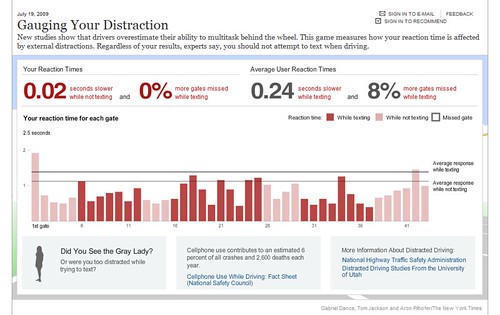TransportGooru Exclusive: Thoughts & observations of a Distracted Driving Summit Participant
The following report about the Distracted Driving Summit is prepared Adam Hopps, a transportation whiz, who participated virtually over the past 2 days (September 30 & Oct 1, 2009), tirelessly taking notes while observing the Summit proceedings online. Shortly after the event finish, Adam e-mailed his observations for sharing it with the rest of the community. Please note that these are Adam’s thoughts and by no means should be considered as a summary of the event. Thanks, Adam for helping us stay informed.
—————————————————————————————————————————————————
Thanks to the US D.O.T.’s efforts at opening up participation in their Distracted Driving Summit, I spent the last two days as one of 5,000 online viewers who watched industry reps, academics, legislators, and policy experts discuss what Secretary LaHood describes as, “the epidemic of distracted driving.”
For those of us not in the building the department also provided an online “chat and tweet room” so that every expert, novice, and personal advocate could give their two cents in response to what was being said live. It’s a perfect symbol of democracy in the Web 2.0 ear, where on one computer screen you can see live a public servant of 20 years desperately trying to convince people to adopt legislation to allow police to enforce drivers who text, while reading “Mark K” write: “We have too many cops. They like things orderly. Freedom is chaotic, so too many cops affects society.”
It’s also a reminder of how transportation is truly a democratic issue – perhaps one of the few issues that affect every individual daily. We all go places every day. We have loved ones who go places. We are doing this constantly, and as the summit pointed out of course, we move dangerously and with reckless behaviors.
The summit drew on a wide variety of people to make this point:
- Victims of distracted driving reminding us of the end results
- Transportation researchers informing us our risk of accident increases 2300% when we text
- Law enforcement officials telling us the type of distraction doesn’t matter – all distractions are deadly
- Legislators preaching to us that we need laws to prevent these behaviors
- AAA reporting that people do it even though they know it’s dangerous
- Wireless companies ensuring us they want to help as much as anyone
- Teens sharing with us the life changing effects of their distracted driving.
. . . . And many more people from all areas of the transportation field reminding us that distracted driving kills.
The value of the summit was in the substance of the presenters and the nature of the experience. Even though Secretary LaHood ended the summit by announcing policy changes and an executive order from the President banning all federal officials from texting while driving, these two days were more about the U.S. DOT engaging academia, industry and public officials on an extremely important topic. Sure, there were plenty of Mark K’s commenting wildly in the chat room, but there were also thousands of people discussing the best way to enforce a texting law, or how to really educated teens on driving or even debating the nature of federal transportation laws.
So the people are engaged, we know we need to end distracted driving, but how do we do it? Two major solutions were presented: Do we create a society where law enforcement is responsible for punishing us when we fall to the temptation to text while driving? Or do we make our technology safer and more intuitive and design systems to prevent distractions?
In his closing, Secretary LaHood laid out the end goal: “Driving while distracted should just feel wrong – just as driving without a seat belt or driving while intoxicated.”
Click here to read the Secretary’s blog about the summit and to replay the proceedings.
Note: Please register your comments/kudos below for Adam in the comments box below.







